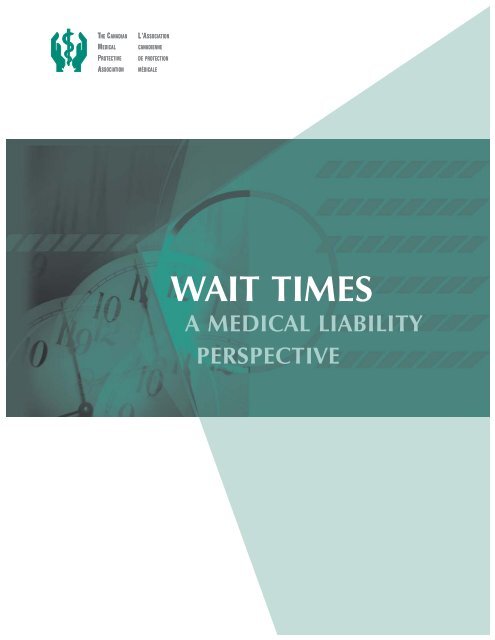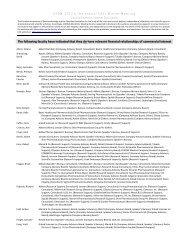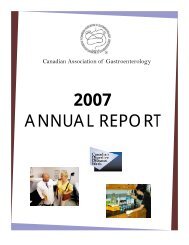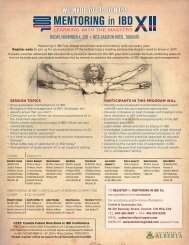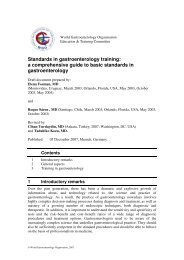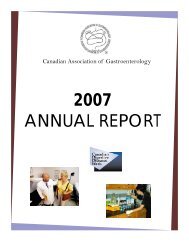Wait Times A Medical Liability Perspective - The Canadian ...
Wait Times A Medical Liability Perspective - The Canadian ...
Wait Times A Medical Liability Perspective - The Canadian ...
You also want an ePaper? Increase the reach of your titles
YUMPU automatically turns print PDFs into web optimized ePapers that Google loves.
WAIT TIMESA MEDICAL LIABILITYPERSPECTIVE
CMPA OBJECTIVESThis paper provides an accountabilityand medical liability perspective onwait times associated with health care. Itidentifies the most salient medico-legalconsiderations associated with the waittimesissue and offers recommendations forpolicy makers, health-care authorities andinstitutions, and physicians. While thepaper highlights accountability andliability concerns that should be addressed,its goal is to contribute to the generation ofappropriate solutions.In offering its recommendations, the CMPAacknowledges that accountability andliability considerations form only oneelement of what should be a comprehensivewait-times plan of action. Nevertheless,these accountability and liability issues, ifleft unresolved, may well hinder theeffectiveness of such a plan of action and, inso doing, undermine the effectiveness ofhealth-care delivery in Canada. <strong>The</strong> CMPA iscommitted to working collaboratively withall interested parties to support a sustainableand effective solution to wait-time concerns.
BACKGROUND4As a starting point, it is perhapsinstructive that the very definition ofwait times is the subject of some debate.Most discussions regarding wait times forhealth care use as the basis ofmeasurement the time between attendanceat a consulting specialist and thecompletion of investigations or treatment.Some important participants in thediscussion, in particular the College ofFamily Physicians of Canada, haveexpressed the view that the determinationof wait times should also take into accountthe time between the patient’s first visitwith his or her family physician and whenrequired, subsequent visits withconsultants, as well as the time it takes fora patient who does not have a familyphysician to find one. 1 Regardless of thedefinition chosen, the CMPA is of theview that a common, clearly communicateddefinition is required and such adefinition should form the basis for allmeasurement activities.It is also important to acknowledge therequirement to wait for access to health careis neither new, nor is it a situation that isrestricted to Canada. Timely access to healthcare is part of a broader issue of limitedhealth-care resources that will likely, to someextent, always be present. It is safe topredict there will always be a gap betweenthe demand for health-care services and theresources available to provide them. Giventhe demand is not constant, completelyeliminating the gap would likely result inexcess capacity. This would result in poormanagement of valuable healthcareresources.Accordingly, the reality is waiting times willnever be zero. While disconcerting for thoseinvolved, manageable queues of patientsawaiting non-urgent and elective proceduresresult in the best use of health-care capacity.If one accepts that the effective managementof health-care wait times will be apermanent requirement, then the need toaddress accountability and liability issuestakes on a strong degree of urgency.In many <strong>Canadian</strong> jurisdictions, and formany clinical conditions, wait times are solengthy they can be challenging to manage.<strong>The</strong>refore, the issue facing the <strong>Canadian</strong>health-care system is how to reduce waittimes and how to manage patients whomust wait for an overly long period of timebefore receiving care. <strong>Wait</strong> times havebecome the focus of considerable publicattention and are, for better or worse, themeasure many people now use to gradeeffectiveness of the health-care system. Inview of the multi-faceted nature of anysolution to reducing wait times, quickprogress on this issue is, while highlydesirable, unlikely. Limiting investment inhealth care, either in the training ofphysicians, nurses and other health-careprofessionals or in the construction andmaintenance of infrastructure, has long-termconsequences. As an example, as Canada andmany other nations have learned fromexperience, resolving a shortage of healthcareprofessionals is not a task that can beaccomplished in the short term. Reversingthese effects requires both immediate actionand a long-term commitment.1When the Clock Starts Ticking – <strong>Wait</strong> <strong>Times</strong> in Primary Care. www.cfpc.ca
Many <strong>Canadian</strong>s, including physicians, haveseen first hand that progress in addressingoverly long wait times for medical treatmenthas been inconsistent across both differenttreatment procedures and differentjurisdictions. One of the most concerningissues for <strong>Canadian</strong>s is the disparity of accessto care across the country. As an example,whether or not a cancer patient will receiveradiation therapy within an establishedbenchmark depends on the type of cancerinvolved, the province/territory withinwhich a patient resides, and the hospitalwhere the patient will receive treatment.<strong>The</strong> inconsistencies in both wait times andthe approaches being pursued to reducethese times undermine confidence in thehealth care system.<strong>The</strong> 2004 First Ministers 10-Year Plan toStrengthen Health Care identified five priorityprocedures as the first phase of a multiphasedeffort to address wait times foraccess to health care. <strong>The</strong>se priorityprocedures are cancer care, cardiac care,diagnostic imaging, joint replacement andsight restoration. While the need to addresshigh-priority procedures as a starting point iswidely acknowledged as being a soundapproach, it has inevitably led to concernsabout resource allocations. As resources areincreasingly focused on the five priorityprocedures, there is an increasing perceptionthat other clinical areas are being“cannibalized” to divert resources to the“Big Five.”A 2006 <strong>Canadian</strong> <strong>Medical</strong> Association onlineconsultation with <strong>Canadian</strong> physiciansrevealed that 55 per cent of physicians citedthe emergence of “have” and “have not”specialties as a result of resources beingdedicated to the five priority areas. <strong>The</strong>media has been replete with stories thatdescribe the “ballooning” effect that resultsfrom prioritizing certain procedures in ahealth-care system that is resourceconstrained and already operating at fullcapacity. This approach places some patientswhose treatment requirements fall outsideone of the five priority clinical areas in adifficult position as they see their wait timeremain overly long and potentially beingextended. Some physicians who treat suchpatients are also being placed in anuntenable position as they struggle to findoperating room time or access to care fortheir patients.As noted above, wait-times management isnot just a <strong>Canadian</strong> problem and ourchallenges are certainly not unique. Almostevery country with a publicly funded healthcare system appears to have some problemswith wait times, and wait times tend toincrease in countries that have public healthinsurance and suffer from constraints oncapacity (e.g. Portugal, the United Kingdom,and Italy). While lengthy waits are negligiblein the United States 2 , the American systemis beset by other access-to-care issues thatmake simplistic comparisons with Canadaproblematic. <strong>The</strong> challenge facing Canadaand many other countries is one of balancingthe demand with the finite amount ofavailable resources.2Tackling Excessive <strong>Wait</strong>ing <strong>Times</strong> for Elective Surgery: A Comparison of Policies in Twelve OECD Countries is available atwww.oecd.org
MANAGING WAIT TIMES —PROGRESS TO DATEAnumber of health care organizationsand blue ribbon groups haveconsidered the current wait-times situationand many have offered recommendationsfor reducing wait times. When viewedindividually, the majority of theserecommendations are generally very soundand, if implemented, would make a usefulcontribution to reducing wait times.However, when viewed in toto, theyhighlight the enormity of the challengefacing the health-care system.In his final report 3 released in June 2006,Dr. Brian Postl, the federal government’s<strong>Wait</strong> Time Advisor, notes the wait-timeinitiative should be viewed as a long-termeffort. His report urges immediate action inthe following areas:• Ongoing research to supportbenchmarking and operationalimprovements;<strong>The</strong> British Columbia <strong>Medical</strong> Association’sCouncil on Health Economics andPolicy report on wait times 4 makes29 recommendations based on existingevidence and research, under five categories:• Building capacity;• Establishing wait time benchmarks for alldiagnostic, therapeutic and surgicalservices;• Developing and implementing wait listmanagement tools;• Improving accountability; and• Funding.For its part, the College of Family Physiciansof Canada has also released a report 5highlighting the significance of the shortageof family physicians as a factor in restrictingtimely access to care.• Adoption of management practices andinnovations in health systems;6• Accelerated implementation ofinformation technology solutions;• Cultural change amongst healthprofessions;• Development of regional surge capacity;and• Public education to support systemtransformation.3Final Report of the Federal Advisor on <strong>Wait</strong> <strong>Times</strong> is available at www.hc-sc.gc.ca4<strong>Wait</strong>ing Too Long: Reducing and Better Managing <strong>Wait</strong> <strong>Times</strong> in BC is available at www.bcma.org5When the Clock Starts Ticking is available at www.cfpc.ca
ACCOUNTABILITY AND LIABILITY<strong>The</strong> concepts of accountability andliability are fundamental both toreducing wait times and to addressingissues that result from an inability toachieve benchmarks and/or careguarantees. Governments, health-careauthorities, hospitals and health-careproviders all have some accountability forproviding health-care services, but thisaccountability needs to be defined in a waythat is practical for all involved.Physician’s duty of care<strong>The</strong> accountability and liability issues facingphysicians as a result of health-care waittimes flow from physicians’ duty of care totheir patients. In law, physicians owe a dutyof care to their patients and they may beheld accountable and liable for damagessuffered by their patients as a result of afailure to fulfill their duty of care. This dutyrequires the physician to exercise care in allthat is done to and for the patient, includingattendance, diagnosis, referral, treatmentand instructions. This duty of care is guidedby the following considerations:• A duty of care arises if there is a doctorpatientrelationship.• A doctor-patient relationship may becreated when the patient is assigned to aphysician for treatment, where thephysician is contacted or consulted abouta patient, or possibly when a patient isplaced on a physician’s waiting list.• <strong>The</strong> scope of the duty of care is unique toeach circumstance and depends on theextent of the physician’s contact withthe patient.Physician accountabilityWithin their particular scope of practice,physicians have a responsibility to directtheir patients’ care. It is generally thephysician who determines whichinvestigations are to be recommended,which prescriptions should be provided andwhich medical and surgical interventions areproposed. Notwithstanding this importantrole in care delivery, physicians do notultimately make many of the decisions thatimpact on service accessibility. Suchdecisions are often made by health-careauthorities and institutions who managephysicians’, and consequently patients’,access to resources.Effective accountability requires those beingheld accountable to have the necessarypowers to effectively carry out their duties.Individuals should therefore be heldaccountable if they have not followedprocedures prescribed to govern theirprofession or to access the resourcesnecessary to enable them to deliver upontheir accountabilities.For this approach to be viable, suchprocedures must be in place and beunderstood and accepted by all involved.<strong>The</strong> CMPA is concerned that, in manyinstances, workable procedures do not exist.In such a circumstance, physicians riskbeing faced with the need to deliver care topatients without having timely access tothe resources necessary to meet theirtreatment obligations.In a world in which timely access to care isnot a problem, managing the queue ofpatients waiting for care would be astraightforward issue. This is often not thecase. Regardless of the length of the queue,physicians remain responsible to placepatients in the queue and to adjust queuepositioning based on changing clinicalpriorities. <strong>The</strong> need to ensure queuemanagement remains adaptable to changingclinical needs can not be overstated. Thisrequires an ongoing monitoring ofpatients to ensure their clinical needsremain paramount.
8Individual and collectiveresponsibilitiesOne of the principal wait-times challengesfacing physicians is the potential conflictbetween a physician’s responsibility to anindividual patient and his/her responsibilityto other patients on the waiting list.Physicians are trained, oriented and, within alegal context, liable to provide a clearlydelineated standard of care to individualpatients. This individual responsibility toone’s patient is a foundation of medicalpractice and it is clearly spelled out and wellunderstood by physicians and, withintheir own scopes of practice, by otherhealth-care professionals.For most patients, the primary contact withthe health-care system is their doctor.Patients expect their physicians, not the“system,” to provide access to care and,when required, to serve as their advocate togain such access. This expectation is unlikelyto change based on government orinstitution-mandated accountabilities.Furthermore, medical professionalregulations and guidelines are almostexclusively based on individual patient care.Physicians and other health care providersare familiar with these regulations and howthey impact care delivery. Issues relating to aphysician’s obligations in relation to theoverall management of the waiting list arerelatively new territory.<strong>The</strong> role of benchmarksOver the past few years, considerableemphasis has been placed on developingbenchmarks for wait times, particularly butnot exclusively for the five priorityprocedures. As government focus has rapidlyshifted from benchmarks to targets to careguarantees, the identification of wait timeshas taken on a new urgency. <strong>The</strong> <strong>Wait</strong> TimeAlliance (a coalition of several stakeholdergroups facilitated by the <strong>Canadian</strong> <strong>Medical</strong>Association) defines benchmarks as “healthsystem performance goals that reflect abroad consensus on medically reasonablewait times for health services delivered topatients.” 6If <strong>Canadian</strong>s are to trust health-care delivery,they need to trust the indicators used tomeasure the performance of the healthcaredelivery system. Notwithstandingefforts to develop that trust, there ismuch work that needs to be done in thedomain of benchmarks.Conflicting measurement methodologieswithin and among provinces/territories areconfusing and result in <strong>Canadian</strong>s trying tocompare apples to oranges. Given the trendto cross-jurisdictional comparisons, thesemethodological inconsistencies are comingunder increasing attention. As an example,the Auditor General for Ontario has recentlyquestioned why provincial wait timescalculated for some of the five priority areascombine in-patient and out-patient waittimes. Given that in-patients generallyreceive their appointments within a day, thismeasurement technique reduces theaggregate average and, in so doing, providesa faulty predictor of the wait time fortreatment likely to be experienced by an outpatient.Similar examples of measurementinconsistencies exist in other jurisdictions.<strong>The</strong> lack of systematic consistency leaves theprocess open to criticism.Reported wait times generally factor inneither waits for consultation nor the timetaken to access family physicians. Forexample, there are indications in Ontariothat, although the time a patient waits forsurgery after being put on a waiting list mayactually be getting shorter, the total waitingtime may not be getting any better due toincreased waits to see specialists followingreferral by a family doctor. A shortage ofcertain specialties contributes to longer waittimes. It appears that a similar situationexists across the country.6It’s about time! is available at: www.waittimealliance.ca
Notwithstanding the challenges associatedwith the establishment and reporting ofbenchmarks, their adoption has served toprovide a measure of system performance.While the benefits of “medically reasonable”benchmarks are evident, there are certainrisks associated with them. <strong>The</strong>se riskslargely involve the evolution of performancebenchmarks to care guarantees andultimately standards analogous to standardsof care.Over time, clinical prioritization has becomeless discretionary and it is now stronglyinfluenced by established standards orguidelines. In establishing the appropriatestandard of care, courts may well place agreat deal of weight on clinical practiceguidelines that are published by medicalorganizations. To date, the courts have notyet fully addressed the extent to whichphysicians, regional health authorities andgovernments may be held liable for injuriessuffered by a patient who does not receivetreatment within the wait-time benchmark.Assuming an ongoing supply and demandgap, a conflict between guidelines for“medically acceptable” wait times andclinical prioritization may well result.Specialty medical societies and others mustbe cautious in contributing to theestablishment of wait-times benchmarksthat could be construed by the courts as arigid standard. <strong>The</strong> danger of applying thesame weight to wait-time guidelines as isaccorded to clinical standards is real and itcould potentially result in a number ofunintended legal consequences.<strong>Medical</strong> liabilitySubsequent to the commitment on the partof Canada’s first ministers to developbenchmarks for “medically acceptable” waittimes in five clinical areas, the <strong>Wait</strong> TimeAlliance (WTA) responded to the challengeof developing medically acceptable waittimes. <strong>The</strong> final report of the WTA inAugust 2005 7 emphasized that wait-timebenchmarks were to be considered “healthsystem performance goals” and included thefollowing statement:<strong>The</strong>y are not intended to be standards norshould they be interpreted as a line beyondwhich a health care provider or funder hasacted without due diligence.Despite this distinction, such goals do, forthe first time in Canada, provide abenchmark against which performance maybe assessed. In addition to forming the basisof wait-time guarantees, these may be alsosignificant from a medico-legal standpoint.<strong>The</strong> recent and rapid evolution frombenchmarks to guarantees heightens thispotential significance.It remains to be determined how the courtsmight respond should civil litigation belaunched if an actual wait time exceeds thewait-time benchmark or guarantee. Giventhis represents largely new legal territory, itis possible any such legal action wouldinclude all players in the health-care deliverysystem, including governments, health-careauthorities, the relevant institutions and anyhealth-care providers involved in thedecision-making process. In terms ofimplications for physicians, from pastexperience, it can be expected that the courtswill likely, based on the individual facts ofthe case, examine what a physician did,what alternatives were considered, and whatefforts were made to obtain the necessarycare for his or her own individual patient. Inother words, the physician could be judgedon his/her actions not only as they relate toproviding care directly but also on his/heractions in gaining access to such care.Any legal action would be furthercomplicated if a patient’s conditiondeteriorated when a wait time exceeded theperformance goal. In many ways, this is the7It’s about time! is available at: www.waittimealliance.ca
10worst possible situation in which a numberof complicating, and possibly extenuating,circumstances converge to disadvantagethe patient.Given the physician’s responsibility toindividual patients, there remains considerablepotential for conflict with his/her as-yetundefinedresponsibilities to other persons onthe waiting list for care. For example, patientsrightfully expect their physician will act ontheir behalf to gain timely access to the careneeded. This gives rise to a potential situationin which a physician might be heldaccountable for not advocating stronglyenough for a patient faced with overly longwait times. Conversely, it might easily giverise to a difficult situation in which aphysician is open to accusations that he/sheadvocated too strongly for an individualpatient at the expense of others with a higherclinical prioritization.Government accountabilityMany stakeholders have advocated twomeasures to incorporate governmentaccountability for wait times – theestablishment of wait-times guarantees andthe withholding of funds when suchguarantees are not met. <strong>Wait</strong>-timesguarantees involve a commitment, on thepart of governments, to deliver treatmentwithin a publicly declared wait-time period.Should such treatment not be availablewithin the province/territory, thenprovinces/territories are expected to pay forthe treatment costs for patients who musttravel to other jurisdictions to receiveservices within the wait-time period.Over the past few years, a number ofprovincial/territorial governments haveestablished wait-times guarantees, either ontheir own volition or, as an outflow from the2007 federal budget, in conjunction with thefederal government. While generallyrestricted to a few selective procedures, theseguarantees represent a rapid evolution frombenchmarks to what are expected to beenforceable standards. For their part,provincial/territorial governments can holdregional and local health authoritiesaccountable through performanceagreements that include specific wait listreduction targets. In turn, it is not surprisingregional and local health authorities andinstitutions appear to be attempting to useaccess to facilities as a means through whichto hold physicians accountable for ensuringthat collective targets are met.Patient safety considerationsAny discussion concerning the effectivemanagement of treatment wait times mustinclude consideration of patient safety. It isforeseeable that efforts to reduce treatmentwait times and to create the most efficientsystem possible will generate concerns aboutpatient safety. <strong>The</strong>re are likely to be bothpositive and negative patient safetyimplications from efforts to reduce waittimes. On one hand, improved access shouldlead to better results as patients receive carein a more timely manner. On the otherhand, the rationing of time and resources toindividual patients in order to enhanceaccess for others may lead to negativeoutcomes. This creates a real dilemma forphysicians.Physicians should be cautious not to sacrificequality medicine in order to achieve highprocess rates. This may well add to frictionsbetween those responsible for managing thesystem and doctors trying to care for theirpatients. An increased emphasis on systemperformance and measurement is likely toexacerbate any such frictions. Courts,regulatory colleges and patients can beexpected to hold physicians accountable forhow they treated individuals – regardless ofthe pressures to “treat” waiting lists. Thisreality is unlikely to go away regardless ofwait-time benchmarks.
RECOMMENDATIONSAnumber of stakeholders haveimportant roles to play in putting inplace mechanisms to address theaccountability and medical liability issuesassociated with health-care wait times.This section identifies key steps that canand should be taken to mitigate theseissues. Success will not however be basedon the actions of one or two of these groupsbut rather on each taking the necessaryactions, both within their own domainsand collectively with others. If true progressis to be made in reducing medico-legal risk,a broad range of actions is required.What should policy makers do?Governments and other policy-makingbodies, particularly at the provincial/territorial level, are key players in addressingmany of the accountability and liabilityissues described in this paper. <strong>The</strong> followingeight proposed actions are all deemed to bereadily achievable by governments,regulatory authorities and other policymakers, and each of these is likely to have atangible and positive impact:• Establish high-level accountabilities thatset common parameters for regionalauthorities and institutions.• Set medically reasonable wait times thatdo not create unreasonable expectations.In this respect, it is crucial to recognizethe wait-times issue is driven as much byexpectations (realistic or otherwise) as it isby other factors.• Standardize wait-time calculationmethodologies and reporting procedures.• Respect the physician’s ethical dilemma ofserving the individual patient as well asthe “wait list.”• Avoid the cannibalization effect whereinwait-time targets for one clinicalprocedure jeopardize access to others.• Monitor the impact of wait times onpatient safety and be prepared toadjust accordingly.• Recognize the requirement for systemflexibility to meet the needs of patientsrequiring more urgent care.• Depict wait times as benchmarks ortargets, not as guarantees.What should health care authoritiesand institutions do?<strong>The</strong> CMPA believes that regional and localhealth-care authorities and institutions, suchas hospitals and clinics, should undertake thefollowing actions to address wait timesrelated to accountability and liability issues:• Establish clear accountabilities thatencompass all elements of the health-caredelivery system, including institutions,physicians and other health careprofessionals.• Communicate these accountabilities to allinvolved, including patients.• Implement effective procedures to managewait times including:– guidelines and tools for effectivelyprioritizing patients, and– methodologies to monitor patientsand re-prioritize queue placementsas required.• Assist physicians in assigning patientsto the queue and in ensuring flexibilityto adapt the queue to changingclinical conditions.• Actively share best wait timesmanagement practices. Greater emphasison sharing practical lessons and bestpractices should have positive results.
12• Implement reliable wait-time reporting.<strong>The</strong> emphasis here is on the words“reliable reporting” that engenders trust inthe health-care system.• Monitor and respond as necessary toinstances of “cannibalization” of services.What should the medicalprofession do?<strong>The</strong> medical profession (specialty societies,national and provincial/territorialassociations and others) can contribute toimproved accountability and liabilitythrough the following realizable actions:• Play a supportive role in the evaluationand determination of medicallyappropriate wait times. Since thelikelihood of targets being interpreted bythe courts and others as de facto standardsis real, the importance of setting realistictargets cannot be over-emphasized.Within a legal environment that is yet tobe fully charted, specialty societies andothers should exercise prudence whencontributing to establishing benchmarks.For example, particular care should betaken to ensure targets are realistic and instating that wait-time benchmarks shouldnot be interpreted as de facto standards.• Advocate for the procedures necessary toensure the management of wait timesleads to better patient care. <strong>The</strong> medicalprofession should seek to leverage thepatient safety benefits inherent in anywait-times reduction initiative, whileactively working to minimize thepotential negative implications.• Require institutions in which physicianswork, whether they are hospitals orclinics, to have clearly-establishedaccountabilities and procedures formanaging treatment wait times.What should referring/consultingphysicians do?For physicians whose wait times may beexceeding the recommended benchmarks, itis important to recognize the courts, inconsideration of the specific facts of the case,may determine the physician owes a duty ofcare from the moment his/her office acceptsa referral, irrespective of whether the patienthas been seen by the physician. Againdepending on the facts of the case, it may beargued that the referring physician continuesto have a duty of care beyond the simple actof referral which may include continuedfollow-up, monitoring, and advocacy forthe patient.<strong>The</strong> following recommendations forphysicians address medical liabilityconsiderations related to treatmentwait times:For the referring physician:• Be aware of the date of the scheduledappointment provided by the consultantand determine if the timing is a cause forsignificant clinical concern.• Consider appropriate ongoing care for thepatient during the period while he/she iswaiting for the appointment.• Inform the patient about the signs orsymptoms for which he/she shouldseek additional medical care during thewait time.• Communicate to the consulting physicianany significant changes in the clinicalcondition of the patient.• Should the clinical condition of yourpatient necessitate an earlier appointmentor should the scheduled appointmentexceed the wait-time benchmark, attemptto negotiate an earlier appointment. If thisis not possible consider referring thepatient elsewhere.
• Document the clinical assessment andany attempts to arrange an earlierappointment.• Monitor patients and re-prioritize queuedpatients as an ongoing responsibility.• Communicate patients’ needs to the careprovidinginstitutions, consultingphysicians and others as required.For the consulting physician:• Notify the referring physician of thescheduled appointment dates.• If, at the time of the referral, the waittime exceeds the benchmarks, consider:– Declining the new consultation andrecommending referral elsewhere, and– Notifying the appropriate institutionthat the wait times are beyond thestated performance goals and that it isnecessary to refer patients elsewhere.– Informing the patients and discussingthe potential adverse consequences ofwaiting, if any;– Discussing alternative treatmentoptions if available, and– Offering possible referral elsewhere.• Be aware of any legislation and/orinstitutional requirements with respect tothe management of wait times.• Monitor patients and re-prioritize queuedpatients as an ongoing responsibility.• Communicate patients’ needs to the careprovidinginstitutions, primary careproviders and others as required.• Document all actions taken in each of theabove circumstances.• Should the wait time begin to exceed therecommended benchmark for patientsalready assessed and on the physician’slist, consider:
CONCLUSIONS14All <strong>Canadian</strong>s recognize the potentiallynegative impact that overly long waittimes can have on patient care.Inappropriately long waits may adverselyaffect patient outcomes, threaten patientsafety, and frustrate patients and theirproviders. Moreover, medicallyunreasonable wait times are a seriousthreat to the confidence <strong>Canadian</strong>s have intheir health care system. Whilerepresenting only the first step in whatmust be a concerted and sustainedcampaign, recent efforts to reduce waittimes are encouraging and should befully supported.Since the root causes of lengthy wait timeshave existed for a number of years, evenwith immediate action, it will take sometime to achieve acceptable solutions. In theinterim, governments, regulatory authorities,regional and local health-care authorities,and health providers, including physicians,must work collectively to resolve theaccountability and liability issues associatedwith wait-times management. It will take acoordinated effort from all parties involved ifthe fundamental questions are to beaddressed. However, until these questionsare adequately addressed, the CMPA remainsconcerned physicians and their patients areat risk.Accordingly, the CMPA is committed toworking with all parties to put in placeworkable solutions to the accountability andliability issues. <strong>The</strong> Association believesimplementation of the recommendationsoutlined above would result in the tangiblereduction in the risk to which its membersand their patients are currently exposed. <strong>The</strong>reduction of such risk should be animportant element of any wait-timesapproach. In this regard, the CMPArecognizes compromises may well berequired if the competing dynamics ofsystem efficiency, patient safety, professionalaccountability, individual liability andpatient expectations are to be met. <strong>The</strong>primary goal should be to ensure every<strong>Canadian</strong> has timely access to high-qualityhealth care.
ReferencesBritish Columbia <strong>Medical</strong> Association.<strong>Wait</strong>ing Too Long: Reducing and Better Managing <strong>Wait</strong> <strong>Times</strong> in BC. (June 2006).www.bcma.org<strong>Canadian</strong> <strong>Medical</strong> Association.It’s About Access! (June 2006)www.cma.caCollege of Family Physicians of Canada.When the Clock Starts Ticking – <strong>Wait</strong> <strong>Times</strong> in Primary Care. (October 2006)www.cfpc.caCollege of Family Physicians of Canada.<strong>Wait</strong> <strong>Times</strong> Position Statement. (Dec. 19, 2005)www.cfpc.caHealth Canada.Final Report of the Federal Advisor on <strong>Wait</strong> <strong>Times</strong>. (June 2006.)www.hc-sc.gc.caNuala Kenny.“Some Ethical Reflections on Accountability.” HealthcarePapers Vol.7 No. 1Nuala Kenny.“Uncharted territory: Hippocratic ethics and health systems.”CMAJ. May 9, 2006. 174(10)www.cmaj.caOECD.Tackling Excessive <strong>Wait</strong>ing <strong>Times</strong> for Elective Surgery: A Comparison of Policies in Twelve OECD Countrieswww.oecd.org<strong>The</strong> <strong>Canadian</strong> <strong>Medical</strong> Protective Association.<strong>Wait</strong>-time benchmarks: Medico-legal considerations, CMPA Information Letter, March 2007www.cmpa-acpm.ca<strong>Wait</strong> Time Alliance for Timely Access to Care.It’s about time! (August 2005)www.waittimealliance.ca<strong>Wait</strong> Time Alliance for Timely Access to Care.Time’s up: Achieving meaningful reductions in wait times (April 2007)www.waittimealliance.ca
Mailing Address: P.O. Box 8225, Station T, Ottawa, ON K1G 3H7 Adresse postale : C.P. 8225, Succursale T, Ottawa ON K1G 3H7Street Address: 875 Carling Ave., Ottawa, ON K1S 5P1 Adresse civique : 875, av. Carling, Ottawa ON K1S 5P1Telephone: 613 725-2000, 1 800 267-6522 Téléphone : 613 725-2000, 1 800 267-6522Facsimile: 1 877 763-1300 Website: www.cmpa-acpm.ca Télécopieur : 1 877 763-1300 Site Web : www.cmpa-acpm.ca


